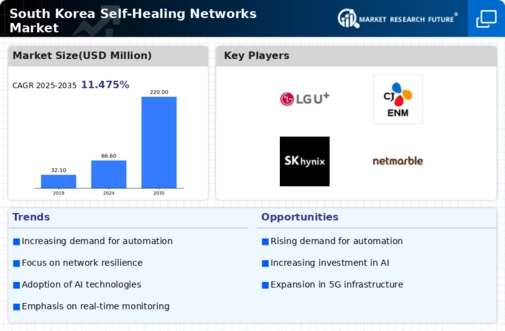Emergence of 5G Technology
The rollout of 5G technology in South Korea is poised to have a profound impact on the self healing-networks market. With its promise of ultra-fast connectivity and low latency, 5G networks will require advanced management solutions to ensure reliability and performance. Self healing capabilities will be crucial in addressing the challenges posed by the increased data traffic and device connectivity associated with 5G. As the number of 5G subscribers is expected to reach 20 million by 2025, the demand for self healing technologies will likely escalate. The self healing-networks market is thus set to benefit from this technological advancement, as organizations seek to implement solutions that can automatically respond to network anomalies and maintain optimal service levels.
Integration of IoT Devices
The proliferation of Internet of Things (IoT) devices in South Korea is significantly influencing the self healing-networks market. With millions of connected devices generating vast amounts of data, the complexity of managing these networks increases. Self healing technologies are essential for maintaining optimal performance and security in such environments. As per industry estimates, the number of IoT devices in South Korea is projected to reach 30 million by 2026, creating a pressing need for robust network management solutions. The self healing-networks market is likely to thrive as organizations adopt these technologies to ensure that their networks can automatically adapt to the dynamic demands of IoT ecosystems, thereby reducing the risk of failures and enhancing user experience.
Growing Cybersecurity Concerns
In South Korea, the escalating concerns surrounding cybersecurity are significantly influencing the self healing-networks market. As cyber threats become more sophisticated, organizations are compelled to adopt proactive measures to safeguard their networks. Self healing technologies offer a promising solution by enabling networks to automatically detect and respond to security breaches. Recent studies indicate that cyberattacks can lead to losses averaging $3.86 million per incident, highlighting the urgent need for robust security measures. The self healing-networks market is likely to see increased investment as businesses prioritize the integration of self healing capabilities to enhance their cybersecurity posture and ensure the integrity of their network infrastructures.
Rising Demand for Network Reliability
The self healing-networks market in South Korea is experiencing a notable surge in demand for enhanced network reliability. As businesses increasingly rely on uninterrupted connectivity, the need for self healing capabilities becomes paramount. This trend is driven by the growing complexity of network infrastructures, which necessitate automated solutions to minimize downtime. According to recent data, network outages can cost companies up to $5,600 per minute, underscoring the financial implications of unreliable networks. Consequently, organizations are investing in self healing technologies to ensure seamless operations. The self healing-networks market is thus positioned to benefit from this rising demand, as companies seek to implement solutions that can autonomously detect and rectify issues, thereby enhancing overall network performance.
Increased Focus on Operational Efficiency
In South Korea, businesses are increasingly prioritizing operational efficiency, which is driving growth in the self healing-networks market. Organizations are recognizing that automated network management can lead to significant cost savings and improved productivity. By implementing self healing solutions, companies can reduce the need for manual intervention, allowing IT teams to focus on strategic initiatives rather than routine maintenance. Reports indicate that companies utilizing self healing technologies can achieve up to 30% reduction in operational costs. This trend suggests that the self healing-networks market will continue to expand as more organizations seek to streamline their operations and enhance their competitive edge through automation.















Leave a Comment